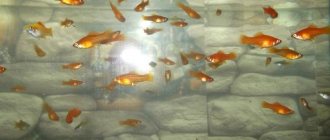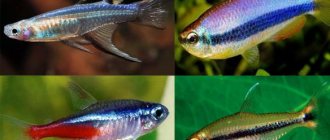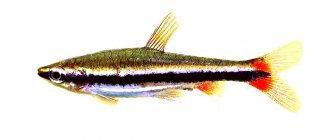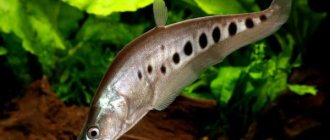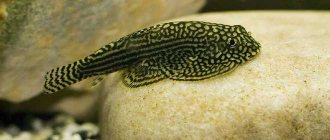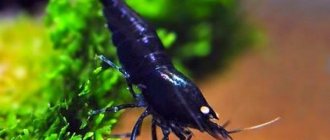Fish diseases
Angelfish
The angelfish is considered the most popular variety of aquarium fish. A distinctive feature of which is good health and interesting territorial behavior. If unfavorable conditions are created, the fish may be susceptible to infectious or foodborne diseases, and if treatment measures are not taken in a timely manner, the fish may die. Diseases of angelfish are either contagious and transmitted to other inhabitants of the underwater world, or not. Often the cause of the disease lies in the provision of poor quality care, as well as the introduction of new inhabitants and plants into the aquarium without prior quarantine.
Description of the fish
What does an angelfish look like? Her appearance is quite unusual. The fish has a flat body, shaped like a crescent. The fins are long and pointed. In an aquarium, angelfish usually grow up to 15 cm; larger specimens are found only in the wild. The length of the body largely depends on the size of the tank. The more spacious the aquarium, the larger dimensions the fish’s body can reach.
The angelfish has red eyes and silvery scales. However, nowadays you can find colorful specimens in aquariums. As a result of selection, blue, black, pearl and golden fish were bred. A characteristic feature is longitudinal dark stripes on the scales.
Conditions
Many aquarists believe that angelfish are unpretentious. However, in order for her to maintain good health, it is necessary to carefully follow certain rules of care and maintenance. The compatibility of the angelfish with other inhabitants of the aquarium is also of great importance.
The conditions for keeping these fish are as follows:
- You need to purchase a fairly large aquarium. Two angelfish require at least 60 liters of water; these fish love space. The height of the tank walls must be at least 50 cm. It is advisable to purchase a rectangular aquarium rather than a round one.
- In nature, angelfish live in schools. Therefore, it is better to purchase several fish at once.
- Very often, angelfish diseases are associated with poor water quality. Therefore, you need to install a powerful filter. It is also necessary to monitor the release of water: these fish do not tolerate too strong a current.
- Under natural conditions, angelfish live in warm climates. Therefore, the water temperature must be maintained at +27-28 °C. In cold conditions, the fish will become sick and grow poorly. At a water temperature of +25 °C, angelfish remain healthy, but cannot reproduce.
- The water needs to be changed at least once a week.
- There should be a lot of algae in the aquarium. Angelfish love to hide among plants. You can put driftwood and other decorations on the bottom of your home pond. However, they should not interfere with the free swimming of pets.
- Fine gravel or sand is suitable as a soil.
- It is better not to use bright light. Angelfish may become frightened by such lighting and get injured. Subdued diffused light is suitable for these fish.
- These fish are unpretentious in food. They can be given dry or live food. You just need to make sure the food is fresh. Angelfish are quite voracious. It is necessary to avoid overeating, otherwise the fish will become sedentary and lethargic.
The angelfish got sick. The eye became cloudy.
Hello, dear users of aqa.ru I encountered the following problem... My scalar got sick, today I noticed that one eye has become cloudy.
He seems to see it. But now it doesn’t swim in a flock like before, but hangs alone in the corner. Appetite is good. The fish has been living for almost a year. And then suddenly the sore came out. I did not introduce any new fish into the akarium. Everything is unchanged. The only thing is that I haven’t changed the water for 2 weeks. I’ve been very tired for the last month, and I still can’t get around to changing the water. And I make changes every week, because my aquarium is fairly populated, and it even seems to me that it’s overcrowded. I feed him frozen bloodworms Aqua Logo, and TetraMin once a week. Maybe the bloodworm has gone bad? And some kind of disease settled in the aquarium? The eye is just cloudy, there is no bulging eyes. And I also noticed that everyone started chasing each other. My patient's entire lower fin was bitten. All other inhabitants are unchanged. Active, healthy. Is a photo of the patient required? Modified 19.1.12 by denny
Hello Danila.
message denny
Is a photo of the patient required? Required.
So start with changing the water using a siphon . Do not feed molasses from AquaLogo. Reduce feeding!
Write the test results.
It can set off the angelfish, otherwise the rest of the fish will attack. Maybe an injury - who hit it in the eye?
Lolita Hello. I didn't expect to hear from you. I'm sorry, I can't post a photo. The card reader on the computer is broken, and I can’t transfer photos from the soap dish to the computer. Today I discovered that the eye has become “protruding” The fish are not particularly chased. But tomorrow I’ll probably put her away at 30L. I hope it will be enough for her? I think we need to decide something now, and not drag it out. Otherwise it will be bad for the fish
I'm waiting for a list of actions for me, Lolita.
denny Buy Sera Baktopur-direct or Antibak 250 from AVZ.
How many cm of angelfish? Have you tested the water in your aqua?
Lolita Tomorrow I will change the water and do tests. Why not today? Let's not be lazy and make a replacement urgently!
DO NOT feed the fish.
Lolita I bought an antibak 250. I installed a 35L sediment tank. Now I'm waiting for the water to heat up. And now I want to ask. The instructions say 1 tablet per 200 liters of water. And for me, that is: half 1/2 - half a tablet, and cut the other half, and dissolve 1 half? Did I calculate correctly? That is, it turns out to be 50 liters of water. It probably won’t be worse if I add a little more medicine?
Modified 1/21/12 by denny
Lolita It probably won’t get any worse if I add a little more medicine? It will be from an overdose.
See how to measure Antibak message shurae Irritation of the dolly's scales
Lolita And for me, that is: half 1/2 - half a tablet, and cut the other half, and dissolve 1 half? Did I calculate correctly? That is, it turns out to be 50 liters of water. 1/2 tablet - per 100l. Divide another 0.5 t in half. - it will be 50l. And cut it off a little more. it will work for 35l.
Or do this:
Crush the tablet into a fine powder (conveniently crush with a teaspoon in a tablespoon). Place the resulting powder in a fold of a piece of paper about 10-15 cm long and about 5 cm wide, folded in half lengthwise. Distribute the powder along the fold as evenly as possible (of course, as you see by eye). Measure the length of the resulting sausage with a ruler and measure out the required portion of the whole. Rake up the desired part and use it for further dissolution in water.
Lolita Now the temperature in the prison is 29 degrees. Fine? In general, I did everything clearly) I added the medicine, everything was as it should be. I put the fisher out a little earlier, not until the water was fully heated, because they began to drive it very hard. She doesn’t feel very well (The second eye also began to become cloudy. Thread-like mucus appeared on her. And it sways around her body like a flag. And the lower fin began to collapse, that is, the shell itself began to collapse and remain like bones (white sticks) I described it as best I could , without a photo it’s hard(Tomorrow I’ll probably still buy a card reader. Very sluggish((Scalar 5-6 cm long. And you’re right, my laziness has no limits.
My very first scalars also died from this disease.. 2 fish
Same symptoms, exactly the same. There were also cloudy eyes, then this mucus began to appear like threads crawling out of the body.
Lolita, I beg you very much. Stay on topic!
I don’t want to lose this scalar, it is my favorite long-lived one. Soon it will be a year since she has been living with me. Sorry if I described it poorly.
Compatibility
Angelfish are not compatible with all types of fish. They can be kept together with the following aquarium inhabitants:
- labio;
- gourami;
- catfish;
- platies;
- tetras;
- irises.
Angelfish are also relatively compatible with barbs, guppies, swordtails, neons, and bettas. But these types of fish can only get along if they were introduced into the same aquarium as fry.
Under no circumstances should you keep an angelfish with the following types of fish:
- Predators and cichlids. These fish can attack the angelfish and cause serious injury to them.
- Telescopes. Angelfish can damage their eyes.
- Goldfish. This type of home pond dweller loves to dig in the ground. As a result, the water becomes cloudy, which is not a suitable environment for angelfish.
Bacterial infections
A small number of pathogenic bacteria may live in the aquarium environment. If their number remains within the normal range, then no diseases are observed in angelfish. If the water changes rarely and there is no sufficient filtration, then pathogenic microorganisms begin to actively multiply. This can lead to the following infectious diseases in aquarium inhabitants:
- fish tuberculosis;
- fin rot (pseudomonosis);
- vibriosis;
- infection with Pseudomonas aeruginosa.
Let's look at these diseases in more detail.
Tuberculosis
The causative agent of fish tuberculosis is mycobacteria. This disease is extremely dangerous, as it spreads very quickly and leads to the rapid death of pets. If an angelfish's eye becomes cloudy, this may be one of the manifestations of tuberculosis. Other external signs of the disease are also noted:
- The scales lose their color and become dull.
- A sick fish tries to hide in a dark place.
- The angelfish looks very emaciated.
- One of the eyes may bulge.
Unfortunately, it is impossible to cure tuberculosis. Sick individuals have to be destroyed, as they are spreaders of a deadly infection. All other fish should be immediately transplanted into a separate aquarium. The water is completely changed, and the soil must be boiled. Individuals who have been in contact with sick fish should be given live food. They can be released back into the aquarium only after 14 days.
Bacteria
Bacteria are another common type of infectious disease. As a rule, pathogenic microorganisms are always present in the aquarium, but when their number exceeds all permissible standards, this negatively affects the health of the aquarium inhabitants. In most cases, tuberculosis and fin rot occur.
Fin rot
Fin rot is a common type of disease affecting fish. Individuals with veil fins are most often affected. If the outbreak is severe enough, the infection can spread to ordinary fish.
Fin rot can be recognized by a number of signs:
- Cloudy eyes and fins.
- The edges of the fins do not have a clear line, they become uneven.
- The fin on the back is torn.
If it is noticed that the fins have begun to tear, then it is worth taking immediate measures to treat the animals, otherwise the infection will begin to progress. If rotting moves from the fins to the body, then you can forget about saving the angelfish.
Tuberculosis
Tuberculosis cannot be cured; the infected individual dies. The sick fish must be destroyed ; the remaining inhabitants of the underwater world are fed live food for 2 weeks. In addition, you will need to change the water and boil the soil.
- You can see clouded and bulging eyes.
- The original body color becomes dull.
- The fish is severely emaciated, its stomach collapses, and its spine is bent.
- A sick angelfish constantly hides in shelters or in thickets of plants.
The animal dies in the shelter found, after which it begins to decompose and spread pathogens of a terrible infectious disease.
Pseudomonosis
Fin rot or pseudomonosis is a dangerous disease that usually affects weakened individuals. This disease occurs quite often in angelfish, as they have long fins. You can immediately notice signs of pseudomonosis if you carefully examine the fish:
- In sick individuals, spots and white coating appear on the fins.
- The edges of the fins become torn and uneven.
- You can notice a tear in the dorsal fin, which in advanced cases reaches the back.
It is necessary to start treating the fish as soon as possible. Otherwise, the pathological process can spread to the muscles and blood vessels, which inevitably leads to the death of the pet. A fish whose fins are completely destroyed cannot be saved.
It is not recommended to place a sick angelfish in a separate tank. The causative agent of pseudomonosis lives in the water, and other fish are most likely also infected. Due to frequent transplants, the fins can become even more damaged. Treatment is best done in a community aquarium. Bactericidal agents are added to the water: “Streptocide”, “Bicillin”, “Biomitsin”. They have a detrimental effect on the pathogen. After the infection is destroyed in the aquarium, the condition of the fish’s fins is gradually restored.
Poisoning
One of the main reasons from which angelfish die and get sick is poisoning with ammonia, chlorine, and nitrite. Some diseases of angelfish begin with poisoning, since the fish have a reduced and weakened immune system.
What causes poisoning and how do the symptoms appear?
- Ammonia poisoning. There is a small amount of oxygen in the water, so the angelfish begins to suffocate. The behavior of the fish changes; they can jump out of the aquarium, which is unusual for them. Angelfish damage their gills, and their body color becomes dark. Excess ammonia is caused by the lack of a filtration unit, a large amount of unused food in the water, and the death of inhabitants.
- Nitrates are not harmful to most fish, but they are very harmful to angelfish. When poisoned, they become lethargic, the gills turn pale, and the fish eat little. Signs of poisoning appear from the first to the third day, sometimes scalars die from nitrate shock.
- Chlorine poisoning causes fish to appear pale and may have red gills and other body parts. The behavior is restless, the angelfish itches, and there is disorientation.
Why else would there be mass death? One of the reasons is overcrowding in the aquarium. The symptoms in this case are similar to poisoning: damaged or red gills, mucus spots on the body, the fish is lethargic and does not eat. This is due to the fact that the new aquarium does not have the necessary biological environment, that is, it has not yet matured. To avoid this, you should monitor ammonia and nitrite levels and take care of biological filters.
Vibriosis
Reddening of the fins of an angelfish may be a manifestation of vibriosis. The causative agent of the disease enters the body through small lesions on the skin. Over time, red spots form not only on the fins, but also on the body. They occur due to hemorrhages. Other signs of the disease are also noted:
- The fish stops eating.
- Becomes lethargic and inactive.
- It stays near the surface of the water and breathes frequently.
Over time, the red spots turn into ulcers. At such an advanced stage of the disease, it is no longer possible to save the pet. Treatment should begin immediately after redness appears. The following medications are added to the food:
- "Furazolidone". You need to crush the tablet and add 500 mg of medication to 25 mg of food.
- "Chloramphenicol." Add 250 mg of medication to 25 mg of feed.
Treatment lasts 6 days. The sick individual should be placed in a separate container, since the drugs negatively affect the balance in the aquarium.
Pseudomonas aeruginosa
When infected with Pseudomonas aeruginosa, fish experience hemorrhages in the mouth and internal organs. An external sign of the disease is the appearance of ulcers on the body.
For treatment, special drugs are used that can be purchased at pet stores:
- Tetra Medica Contralck.
- Tetra Medica General Tonic.
These are antibiotic solutions. They are added to water in the proportion of 5 ml of medicine per 20 liters of liquid. In severe cases, a dosage of 10 ml is used. Unfortunately, it is not always possible to cure fish from this disease; some of the inhabitants of the aquarium die.
Protozoa
Most often, the body of the angelfish is affected by protozoa, which in turn can cause a number of diseases. The following symptoms will make it much easier to recognize the presence of this type of infection:
- The lateral line is deformed.
- Waste products change their color to white.
- The feces are thin, resembling white thin threads, and they are quite long.
If the condition is satisfactory, it is quite possible to save the animal; to do this, it is enough to select special preparations at the pet store. In severe cases, death is inevitable.
Attention! All fish that were with an infected individual must be treated for preventive purposes.
Parasites
If the angelfish does not eat, this may be a sign of the presence of parasites. Pathogens are divided into 3 groups:
- parasitic worms;
- microsporidia;
- protozoa.
Infection with worms does not appear immediately. The first signs of invasion appear at advanced stages of helminthiasis. Symptoms of infection are as follows:
- The fish stops eating and looks exhausted.
- Angelfish move little, often lie on the bottom, and do not respond to light and sounds.
- The color and shape of stool changes.
If the angelfish has a swollen belly, this indicates a severe helminthic infestation. Swelling of the abdominal cavity is a sign that the internal organs are filled with parasites. Often the fish dies from a rupture in the abdomen.
For treatment, the anthelmintic drug JBL Nedol Plus 250 is used. It is added to the general aquarium, since when infected with worms, all fish are subject to treatment, and not just individuals with signs of invasion. The dosage of the product is indicated in the instructions for use.
Microsporidia are fungi that parasitize inside cells. Infected fish exhibit the following symptoms:
- black dots on scales;
- low mobility;
- complete lack of appetite.
It is impossible to cure this dangerous angelfish disease. The infected fish must be urgently isolated from the rest of the aquarium inhabitants. It is very important to prevent infection of the remaining inhabitants of the aquarium. It is necessary to completely replace the water and soil in the tank. All care accessories should also be treated with bactericidal agents. Then you need to add a solution of methylene blue to the aquarium. The prophylactic dose specified in the instructions is used. Fish should be given only live food; natural food will help increase the body's resistance.
Angelfish are often infected with protozoan parasites from the flagellate class. These microorganisms cause a disease in fish - hexamitosis. The external manifestations of this disease are as follows:
- sores on the head;
- the appearance of feces in the form of a thin white thread;
- change in the shape of the lateral line.
Sometimes angelfish experience rectal prolapse. However, this is not always a sign of hexamitosis. This symptom is also observed if the fish overeats. Hexamitosis is treated with Metronidazole. The drug is added to the general aquarium.
The main reason for strange behavior is overeating
There can be many reasons why a fish swims sideways. Often, it can be saved if the right actions are taken in time.
The first reason is overfeeding. Fish are voracious, so it is important to time their meals and ensure that no food remains. Otherwise, the water will be polluted prematurely and a favorable environment will arise for the development of putrefactive bacteria. In addition, the fish may develop serious digestive problems, including intestinal blockage and death. Angelfish react especially acutely to overfeeding.
If they begin to float upside down or lie on their sides on the bottom, but look completely healthy, then most likely this is the result of overeating. Place the fish and give it a fasting day for at least a day.
Observe the food storage conditions. Pour a small amount into a convenient container that can be refilled as needed, with a tight-fitting lid.
Fungi and viruses
These microorganisms usually multiply in contaminated water. Most often, angelfish have the following fungal and viral infections:
- Glucose. This is a very dangerous disease that cannot be cured. Most of the fish die. White rashes appear on the body of the sick individual. The angelfish loses coordination of movements and constantly lies on its side. Sick fish must be destroyed. The aquarium must be thoroughly treated and the water and soil must be completely replaced. This will help prevent the spread of infection.
- Dermatomycosis. The cause of this disease is mold. A white coating appears on the body of the angelfish. Sometimes there are eyesores. It is very important to start treatment at the stage of scale damage, otherwise the fungus will penetrate into the internal organs. The drug “Streptocide” is added to the general aquarium. Salt baths are also useful; they are carried out in a separate container.
- Ichthyosporidiosis. The fungus affects internal organs, so external signs of infection may not be immediately noticeable. In sick fish, the scales rear up and darken, the eyes become bulging. The angelfish loses its appetite. When the nervous system is damaged, coordination of movements is impaired. The fish first moves in jerky movements, and then sinks to the bottom and lies on its side. Convulsions may occur. Treatment of this disease is possible only at an early stage. Funoksitol solution is added to water and dry food. After treatment is completed, all water in the aquarium is replaced.
- Rubella. This is a highly contagious viral pathology. The infection spreads very quickly in the aquatic environment. Red spots appear on the belly of the angelfish. There is inflammation and hyperemia in the gill area. Treatment has not been developed; rubella most often leads to the death of fish.
Intoxication
Most often, fish die from intoxication. The reason for this is not only poor-quality food, but also the appearance of toxic compounds in the tank. If you rarely change the water in the aquarium, the concentration of ammonia may increase. This substance is constantly formed as a result of the vital activity of fish. Signs of ammonia poisoning are:
- fish floating to the surface of the water;
- attempts to jump out of the aquarium;
- rapid breathing;
- lack of coordination;
- darkening of scales;
- redness of the gills.
To save the fish from poisoning, you need to immediately change the water. Then you should add hydrogen peroxide to the tank. This will help increase the amount of oxygen.
Poisonous nitrates and nitrites can also accumulate in the aquarium. These are ammonia breakdown products. When intoxicated with these substances, angelfish lose coordination of movements. The fish swim on their backs or sides, and sometimes even upside down. If measures are not taken, the inhabitants of the aquarium may die from poisoning. It is urgent to replace the water and provide powerful filtration.
The angelfish loses its sight.
The angelfish loses its sight.
Message from Yu.V. » 06 Jan 2015, 14:19
Filling out the questionnaire in the section 'Diseases of aquarium fish' 1. Description of the symptoms of the disease: Angelfish loses vision. Corneal clouding is clearly visible in one eye. The same thing starts on the second one. There seem to be no problems with moving around the aquarium. Approaching the front window, when feeding begins too. But he practically doesn’t see the food. It doesn’t take in the water column at all. On the surface it often misses the food. I have to feed with tweezers. At the same time, it is clearly visible that from the side of her clouded eye she cannot even see the tweezers. 2. Volume/dimensions of the aquarium: 250 3. When the aquarium was launched: 3 years ago. In the summer there will be a partial relaunch due to the redesign. 4. Water parameters: Ammonia, nitrite zero. Nitrate 10-15. Phosphate up to 0.5. KN 9-10. 5. Fish in the aquarium: Two black velvet angelfish, large, two golden angelfish - juveniles, 4 pearl gouramis, Malabar danios, ancistrus, sturisoma, corydoras, Siamese pangasius (17 cm), some small characinka. 6. Plants in the aquarium: Medium density, different. 7. Plant nutrition: Reinforced concrete balls under the roots when restarting 8. Supply of carbon dioxide (CO2): None 9. Soil in the aquarium: Substrate - lava. Rounded basalt on top 10. Decorations in the aquarium (driftwood, stones, decorations, etc.): Stones (moderate amount, neutral), 2 driftwood. 11. Filtration: Samopal at 1000 l/h (actual pumping), false bottom 12. Temperature in the aquarium: 24 13. Aeration: Only at night 14. Water change in the aquarium: 20% 2-3 r/week 15. Is there direct light? from the window to the aquarium: No 16. Lighting in the aquarium: LED spotlight with a total power of 60 W. 35 lm/l, 6500K 17. Feeding: 2 daily chips, frozen 18. Recent changes: None
More than a year ago, parasites were driven off from this angelfish and hex was treated (Narine, if he looks into the topic, will probably remember). Since then, there have been no problems with her health or behavior. Well, a couple of months after treatment, small pockets of bacteria periodically appeared on the body, which went away on their own. There were definitely no problems for a year, except for vision problems. Is there any way to really help her recover? Thank you.
What to do in case of fish diseases
If changes in appearance and behavior are detected in the angelfish, then most likely the fish is sick. It needs to be placed in a separate container to prevent infection of other individuals. It is also necessary to examine the body of the fish with a magnifying glass. Then you need to check the quality of the water in the aquarium using special tests. If the fish does not have external signs of illness, and the fluid analysis did not reveal any deviations from the norm, then it needs to be kept in quarantine for several days. If changes in behavior (lethargy, loss of appetite, lack of coordination) persist, then the pet must be taken to the veterinarian.

